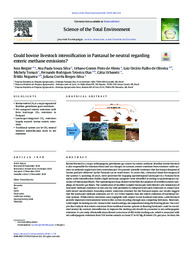Could bovine livestock intensification in Pantanal be neutral regarding enteric methane emissions?
Could bovine livestock intensification in Pantanal be neutral regarding enteric methane emissions?
Autoria: BERGIER, I.; SILVA, A. P. S.; ABREU, U. G. P. de; OLIVEIRA, L. O. F. de; TOMAZI, M.; DIAS, F. R. T.; URBANETZ, C.; NOGUEIRA, E.; SILVA, J. C. B.
Resumo: Bovine livestock is a major anthropogenic greenhouse gas source via entericmethane. Brazilian bovine livestock is also responsible for emissions from land-use changes. In contrast, enteric emissions from extensive cattle systems in wetlands might have been overestimated.We provide scientific evidences that the human footprint of bovine products delivered by the Pantanal can be much lower. To assess this, a historical cloud-free imagery of the Landsat-5, spanning 26 years, were processed for mapping spatiotemporal landscapes in a Pantanal farm under cattle intensification studies. Eight landscape categories were identified according to spatiotemporal dynamics of interannual floods. The spatiotemporal map allowed in the field the adoption of stratified randomsamplings of chamber gas fluxes. The combination of stratified sampled landscapes with Monte Carlo simulations of measured methane emissions in wet and dry soils permitted to integrate landscapes emissions at annual basis with biased uncertainties. Assuming enteric emissions obtained for the Pantanal region, our results suggest that the landscapes methane emissions are 10- to 23-fold superior than the enteric emissions of traditional bovine systems. While enteric emissions seem negligible with respect to net farmland emissions, cattle livestock provide important environmental services like carbon recycling through non-competing herbivory. Moreover, cattlemight be making use of a biomass thatwould undergo decomposition during the flooding phase. Our analysis thus indicate that enteric emissions from traditional bovine systems in flooding farmlands could be considered neutral. By contrast, intensification to improve the stocking rate should be accounted as net anthropogenic emissions. A case study of intensification allowed an increase of 48% in the stocking rate,which is associatedwith net anthropogenic emissions from534 bovine animals or about 27 to 63Mg of enteric CH4 per year. In short, the competition between traditional and distinct levels of cattle intensification will result from a trade-off between public policies and strategic market niches (organic, sustainable) for the optimal landscape management of the Pantanal.
Ano de publicação: 2019
Tipo de publicação: Artigo de periódico
Unidade: Embrapa Pantanal
Palavras-chave: Beef, Beef cattle, Cattle, Ecology, Efeito Estufa, Floods, Greenhouse gases, Landscapes, Livestock, Metano, Methane, Pecuária
Observações
1 - Por padrão são exibidas publicações dos últimos 20 anos. Para encontrar publicações mais antigas, configure o filtro ano de publicação, colocando o ano a partir do qual você deseja encontrar publicações. O filtro está na coluna da esquerda na busca acima.
2 - Para ler algumas publicações da Embrapa (apenas as que estão em formato ePub), é necessário ter, no celular ou computador, um desses softwares gratuitos. Sistemas Android: Google Play Livros; IOS: iBooks; Windows e Linux: software Calibre.
Acesse outras publicações
Acesse a Base de Dados da Pesquisa Agropecuária (BDPA) para consultar o acervo completo das bibliotecas da Embrapa.

